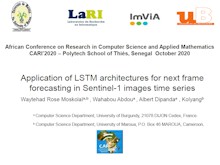
Waytehad Rose Msokolaï
Application of LSTM architectures for next frame forecasting
in Sentinel-1 images time series
Waytehad Rose Moskolaïa,b – Wahabou Abdoua – Albert Dipandaa -Kolyang,b
a Computer Science Department, University of Burgundy, 21078 DIJON Cedex, France,
b Computer Science Department, University of Maroua, P.O. Box 46 MAROUA, Cameroon
RÉSUMÉ. L’analyse prédictive permet d’estimer les tendances des évènements futurs. De nos jours, les algorithmes Deep Learning permettent de faire de bonnes prédictions. Cependant, pour chaque type de problème donné, il est nécessaire de choisir l’architecture optimale. Dans cet article, les modèles Stack-LSTM, CNN-LSTM et ConvLSTM sont appliqués à une série temporelle d’images radar sentinel-1, le but étant de prédire la prochaine occurrence dans une séquence. Les résultats expérimentaux évalués à l’aide des indicateurs de performance tels que le RMSE et le MAE, le temps de traitement et l’index de similarité SSIM, montrent que chacune des trois architectures peut produire de bons résultats en fonction des paramètres utilisés.
ABSTRACT. Predictive analytics allow to estimate future trends of events. Nowadays, Deep Learning algorithms allow making good predictions. However, it is necessary to choose the architecture that produces the most efficient results for each kind of problem. In this paper, the Stack-LSTM, the CNN-LSTM and the ConvLSTM models are applied to a time series of sentinel-1 radar images. The goal is to predict the next occurrence in a sequence of images. Experimental results are evaluated with performance metrics such as the RMSE and MAE loss, the processing time and the SSIM index. The values show that each of the three architectures can produce good results depending on used parameters.
MOTS-CLÉS : Apprentissage profond, LSTM, Prédiction, Images satellitaires, Prévision, Changements couverture terrestre.
KEYWORDS: Deep Learning, LSTM, Prediction, Satellite images, Forecasting, Land cover change



